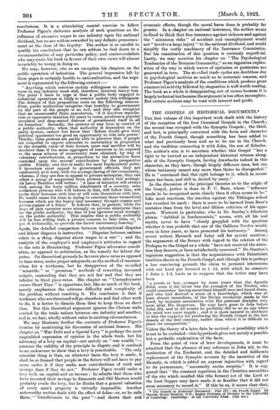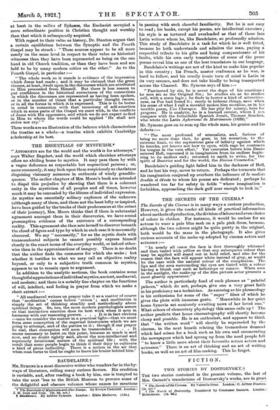of the reception of the four Canonical Gospels in the
Church ; the second was occupied with the Synoptic Gospels ; the third, and last, is principally concerned with the form and character of the Fourth Gospel, though something has been added to what had previously been said as to its use in the Church, and the tradition connecting it with John, the son of Zebedee.
The author's aim is to ascertain whether this Gospel " has a right to be treated as an independent historical witness along- side of the Synoptic Gospels, having drawbacks indeed in this
character, as they have, though largely different ones, but one whose testimony cannot any more than theirs be disregarded." He is " convinced that this right belongs to it, which in recent times has been, and still is, denied by many."
In the discussion of the principal theories as to the origin of the Gospel, justice is done to F. C. Baur, whose " influence needs to be recognized more clearly than it often seems to be." Like most reactions, the reaction against the Tubingen school has overshot its mark : there is more to be learned from Baur's mistakes than from the level and lifeless criticism of his oppo- nents. Westcott in particular, who in Dr. Sanday's felicitous phrase " dabbled in fundamentals," seems, with all his real
merits, never to have " closely grappled with the question whether it was probable that one of the Galilean Twelve would,
even in later years, so have presented his testimony." Among recent writers Harnack and Loisy call for special mention ; the arguments of the former with regard to the relation of the Prologue to the Gospel as a whole " have not received the atten- tion they deserve, or been satisfactorily answered." Dr. Stanton's ingenious suggestion is that the acquaintance with Palestinian localities shown in the Fourth Gospel, and (though this is perhaps a less convincing ground) the claim to personal intercourse with our Lord put forward in i. 14, with which he connects 1 John i. 1-3, leads us to suppose that the writer may have been
" a youth or boy, younger by some years than the Apostle John, even if the latter was the youngest of the Twelve, who could remember having sometimes himself seen and heard Jesus, and who had derived a sense of a knowledge, which was at least almost immediate, of the Divine revelation made in the Lord, by intimate association with His personal disciples very soon after His departure. He may have gone to Asia before John did, and at all events he probably did so at an age when his mind was more supple ; and it is more natural to attribute to him the capacity for producing the. Fourth Gospel in the last decade of the first century, earlier than which it is difficult to place its composition."
Unless the theory of a later date be revived—a possibility which is not to be excluded—this hypothesis gives not merely a possible but a probable explanation of the facts.
From the point of view of later developments, it must be admitted that the absence of any reference in John xiii. to the institution of the Eucharist, and the detailed and deliberate replacement of the Synoptic account by the narrative of the Maundy, to which is added an express injunction with regard to its permanence, " necessarily excite surprise." It is sug- gested that " the constant repetition in the Christian assemblies of the rite which recalled this (the former) act of the Lord at the Last Supper may have made it so familiar that it did not seem necessary to record it" If this be so, it seems clear that,
• The Gospels as Ilistorteal Documents. Part the Fourth Gospel. By Vincent Henry Stanton, D.D., Regius Professor of Divinity In the University of Cambridge. Cambridge: at the University Press. [20s. net.] at least in the milieu of Ephesus, the Eucharist occupied a more subordinate position in Christian thought and worship than that which it subsequently acquired.
With regard to their value as history, Dr. Stanton argues that a certain equilibrium between the Synoptic and the Fourth Gospel may be struck : " These sources appear to be all more nearly on the same level in respect to their value as historical witnesses than they have been represented as being on the one hand in old Church tradition, or than they have been and are held to be by many modern critics on the other." As to the Fourth Gospel, in particular :- " The whole work as it stands is evidence of the impression which Jesus had made ; and it may be claimed that the great themes, at least, dwelt upon in the discourses which are attributed to Him proceeded from Himself. But there is less reason to put confidence in the historical correctness of the connexions in which the discourses are represented as having been spoken, or in the number of times that a particular thought recurs, or in all the forms in which it is expressed. This is to be borne in mind in connexion with that monotony of self-assertion which in some parts of the Gospel we meet with, in the conflicts of Jesus with His opponents, and which we do not expect to find in Him to whom the words could be applied He shall not strive nor cry.' "
These words are an illustration of the balance which characterizes the treatise as a whole—a treatise which exhibits Cambridge scholarship at its best.



































 Previous page
Previous page